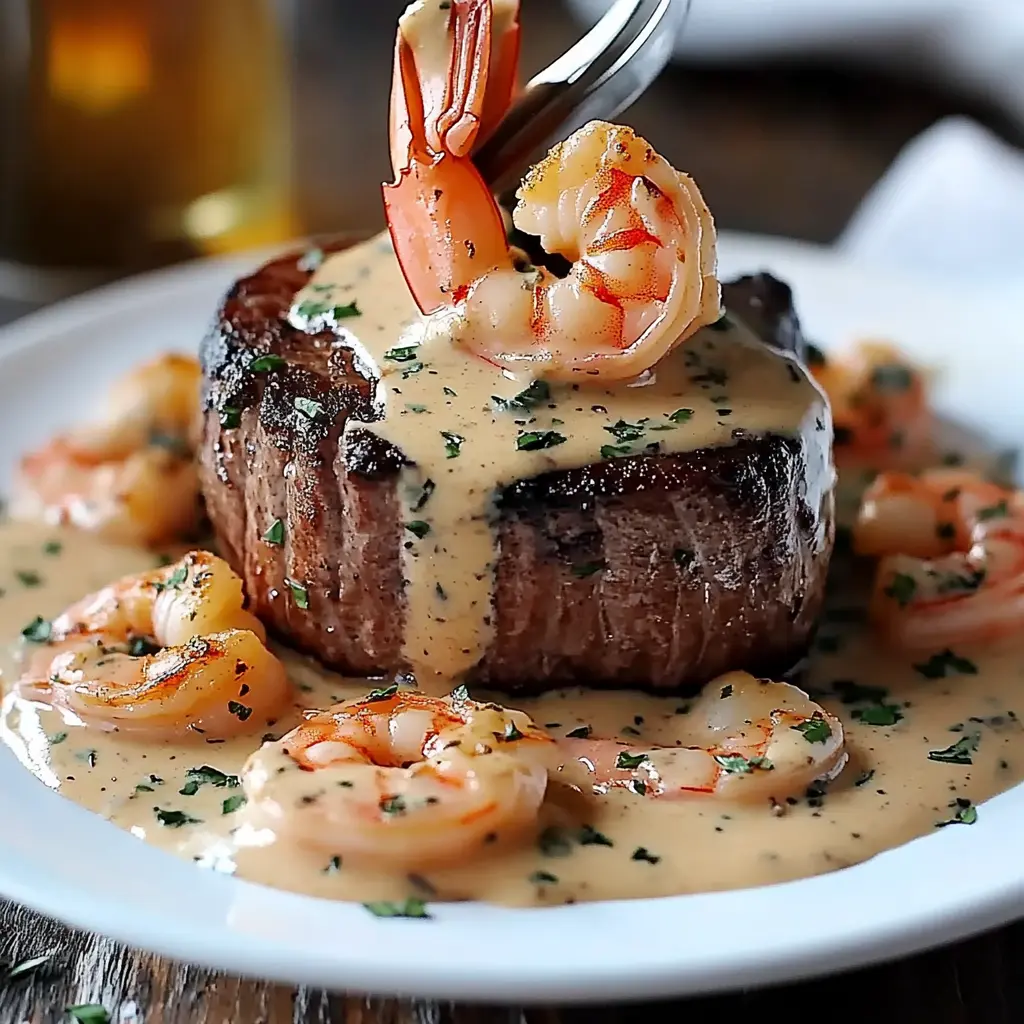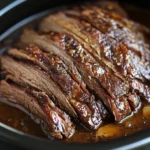Description: This recipe elevates the classic filet mignon to a luxurious dining experience. Tender, perfectly seared filet mignon steaks are crowned with a decadent cream sauce bursting with the sweet flavors of shrimp and lobster. It’s an impressive dish that’s surprisingly easy to prepare, perfect for a special occasion or a romantic dinner.
Why You Will Love This Recipe:
- Unforgettable Flavor: The combination of the rich, buttery filet mignon with the sweet, briny seafood cream sauce creates a symphony of flavors that will tantalize your taste buds.
- Impressive Presentation: This dish looks like it came straight from a five-star restaurant, making it perfect for wowing your guests.
- Surprisingly Simple: Despite its elegant presentation, this recipe is relatively straightforward and can be made in under an hour.
- Versatile: While the recipe calls for shrimp and lobster, you can adapt the sauce with other seafood, like scallops or crab, based on your preference and availability.
- Customizable Doneness: Easily adjust the cooking time of the filet mignon to achieve your perfect level of doneness, from rare to well-done.
Introduction
Filet mignon, renowned for its tenderness and delicate flavor, is a steakhouse favorite for a reason. Its buttery texture and melt-in-your-mouth quality make it a truly special cut of beef. However, sometimes, even the most classic dishes can benefit from a touch of extravagance. This recipe transforms the simple elegance of filet mignon into a culinary masterpiece by pairing it with a luscious shrimp and lobster cream sauce.
The sauce itself is a study in simplicity. Sautéed garlic infuses the base with a warm, aromatic note, while a splash of vegetable or chicken broth deglazes the pan, capturing all the flavorful browned bits left behind from searing the steaks. Heavy cream adds richness and body, creating a velvety texture that perfectly coats the shrimp and lobster. These seafood delicacies lend their natural sweetness and briny notes to the sauce, creating a flavor profile that is both indulgent and balanced.
This recipe is perfect for a romantic date night, a celebratory dinner, or any occasion that calls for something truly special. It’s a showstopper that will impress your guests without requiring hours in the kitchen.
Ingredients:
- 4 filet mignon steaks (6-8 ounces each, about 1.5 inches thick)
- 8 large shrimp, peeled and deveined
- ½ cup lobster meat, chopped (fresh or frozen, thawed)
- 1 cup heavy cream
- 3 tablespoons butter, divided
- 2 cloves garlic, minced
- ¼ cup vegetable or chicken broth
- Fresh parsley, chopped (for garnish)
- Salt and freshly ground black pepper, to taste
Preparation:
Step 1: Prepare the Filet Mignon
Begin by removing the filet mignon steaks from the refrigerator approximately 30 minutes before cooking. This allows them to come to room temperature, which ensures more even cooking. Pat the steaks dry with paper towels. This is crucial for achieving a good sear. Season the steaks generously on all sides with salt and freshly ground black pepper. Don’t be shy with the seasoning – it’s what brings out the natural flavor of the beef.
Step 2: Sear the Filet Mignon
Place a heavy-bottomed skillet, preferably cast iron, over medium-high heat. Add 1 tablespoon of butter to the skillet and let it melt completely. The skillet should be hot enough that the butter sizzles immediately. Carefully place the seasoned filet mignon steaks into the hot skillet, ensuring they don’t overcrowd the pan. Sear the steaks for 4-5 minutes per side, or until they develop a rich, golden-brown crust. For medium-rare, aim for an internal temperature of 130-135°F (54-57°C). Adjust the cooking time based on your desired level of doneness:
- Rare: 120-130°F (49-54°C)
- Medium-Rare: 130-135°F (54-57°C)
- Medium: 135-145°F (57-63°C)
- Medium-Well: 145-155°F (63-68°C)
- Well-Done: 155°F (68°C) and above
Use a meat thermometer to ensure accuracy.
Step 3: Rest the Filet Mignon
Once the steaks are cooked to your liking, remove them from the skillet and place them on a clean plate. Cover loosely with foil and let them rest for at least 5 minutes. This allows the juices to redistribute throughout the meat, resulting in a more tender and flavorful steak. Resting is a crucial step that should not be skipped.
Step 4: Prepare the Shrimp and Lobster Cream Sauce
While the steaks are resting, return the skillet to medium heat and add another tablespoon of butter. Once the butter is melted, add the minced garlic and sauté for about 1 minute, or until fragrant. Be careful not to burn the garlic, as this will give the sauce a bitter taste. Add the shrimp and lobster to the skillet and cook for 3-4 minutes, or until the shrimp turns pink and opaque and the lobster is heated through. Remove the shrimp and lobster from the skillet and set aside.
Step 5: Create the Cream Sauce
Deglaze the skillet by pouring in the vegetable or chicken broth. Use a spatula to scrape up any browned bits from the bottom of the pan. These browned bits, known as fond, are packed with flavor and will add depth to the sauce. Let the broth simmer for a minute or two to reduce slightly.
Pour in the heavy cream and bring the mixture to a simmer. Reduce the heat to low and simmer for 3-5 minutes, or until the sauce has thickened to your desired consistency. Season the sauce with salt and pepper to taste. Return the cooked shrimp and lobster to the skillet and gently toss to coat them in the cream sauce. Heat through for another minute.
Step 6: Assemble and Serve
Place the rested filet mignon steaks on individual serving plates. Spoon the shrimp and lobster cream sauce generously over the top of each steak. Garnish with freshly chopped parsley for a pop of color and freshness. Serve immediately and enjoy.
COOKING Rating:
- Difficulty: Easy to Medium
- Taste: Exceptional
Serving Suggestions:
- Serve alongside roasted asparagus, garlic mashed potatoes, or a simple green salad for a complete and balanced meal.
- Pair with a crisp white wine, such as Chardonnay or Sauvignon Blanc, to complement the richness of the dish.
Tips:
- For the best flavor, use fresh, high-quality filet mignon steaks.
- Don’t overcook the filet mignon. It’s best served medium-rare to medium.
- If you don’t have lobster meat, you can substitute with crab meat or extra shrimp.
- For a richer sauce, add a splash of dry sherry or white wine when deglazing the pan.
- Adjust the amount of garlic to your preference.
- If the sauce becomes too thick, add a splash of broth or cream to thin it out.
- For a spicier sauce, add a pinch of red pepper flakes.
- To elevate the flavor you can add the lobster body and shrimp shells to your chicken broth to get an even more profound taste. Be careful not to boil for too long as this will make your sauce extremely fishy.
- After searing your Filet Mignon, you can add a tablespoon of butter and use a spoon to pour over the hot butter and sear the sides for a perfectly cooked filet.
Prep Time: 15 minutes
Cook Time: 25 minutes
Total Time: 40 minutes
Nutritional Information (Per Serving, approximate):
- Calories: 650-750 (estimated, will vary based on portion sizes and specific ingredients)
- Protein: 50-60 grams
- Sodium: 500-700mg (estimated, will vary based on seasoning and broth)
Conclusion
This Filet Mignon with Shrimp and Lobster Cream Sauce is a truly special dish that is perfect for any occasion. The combination of tender, perfectly seared filet mignon with the rich and flavorful seafood cream sauce is simply irresistible. While it may seem like a restaurant-quality dish, it is surprisingly easy to make at home. So, the next time you want to impress your guests or treat yourself to a luxurious meal, give this recipe a try. You won’t be disappointed. Enjoy!
Questions and Answers About This Recipe
Q1: Can I use frozen filet mignon steaks for this recipe?
A: Yes, you can use frozen filet mignon steaks, but it’s essential to thaw them completely before cooking. The best way to thaw them is in the refrigerator overnight. This ensures even thawing and prevents bacterial growth. Avoid thawing at room temperature or in the microwave, as this can compromise the texture and flavor of the meat.
Q2: What if I don’t have lobster meat available? Can I substitute it with something else?
A: Absolutely! If you don’t have access to lobster meat, you can substitute it with crab meat or even increase the amount of shrimp in the recipe. Scallops would also make a delicious addition or substitute. The key is to choose a seafood that complements the richness of the cream sauce.
Q3: How can I ensure my filet mignon is cooked to the perfect level of doneness?
A: The best way to ensure your filet mignon is cooked to your desired level of doneness is to use a meat thermometer. Insert the thermometer into the thickest part of the steak, avoiding any bone or fat. Refer to the internal temperature guide provided earlier in the recipe to determine when the steak has reached your desired level of doneness. Remember that the internal temperature will continue to rise slightly after you remove the steak from the heat, so it’s best to remove it when it’s a few degrees below your target temperature.
Q4: Can I make the shrimp and lobster cream sauce ahead of time?
A: While you can make the sauce ahead of time, it’s best to make it fresh for the best flavor and texture. If you do make it ahead of time, store it in an airtight container in the refrigerator for up to 24 hours. When reheating, add a splash of cream or broth to thin it out if it has thickened too much. Be careful not to overcook the shrimp and lobster when reheating, as they can become tough and rubbery.
Q5: What kind of skillet is best for searing the filet mignon?
A: A heavy-bottomed skillet, preferably cast iron, is ideal for searing filet mignon. Cast iron skillets retain heat very well, which is essential for achieving a good sear and even cooking. If you don’t have a cast iron skillet, you can use a stainless steel skillet with a thick bottom. Avoid using non-stick skillets, as they don’t get hot enough to sear the meat properly.




